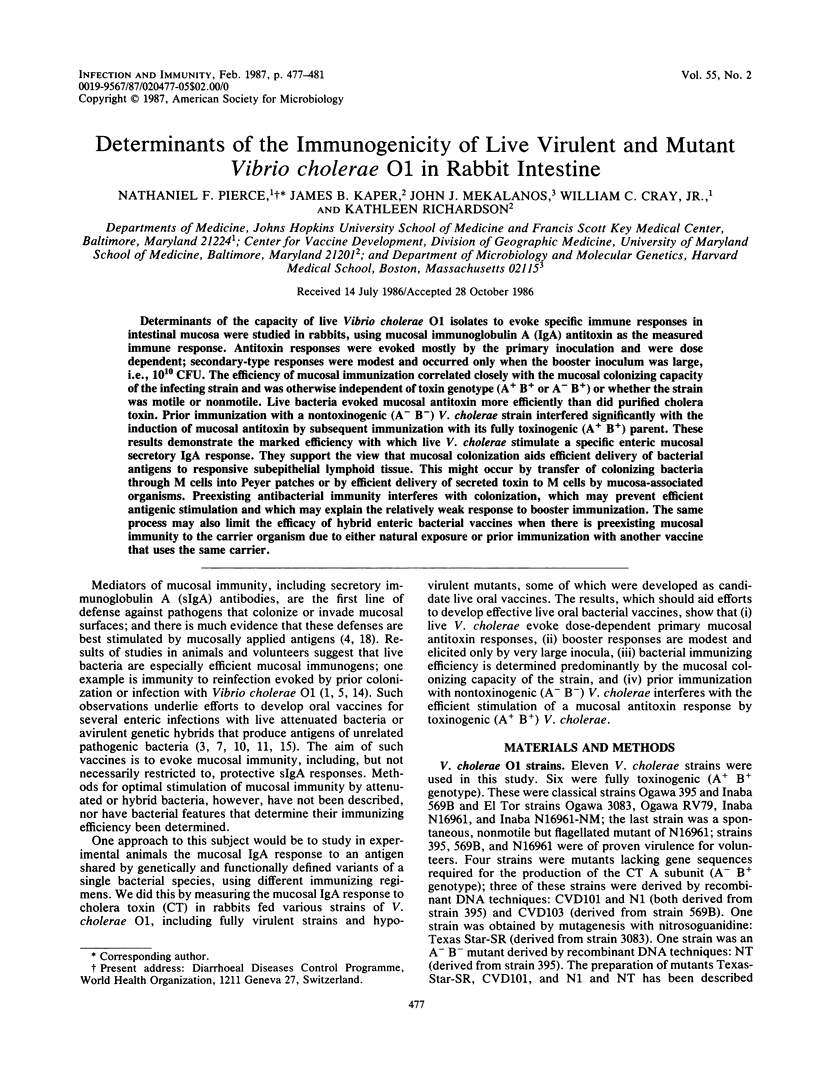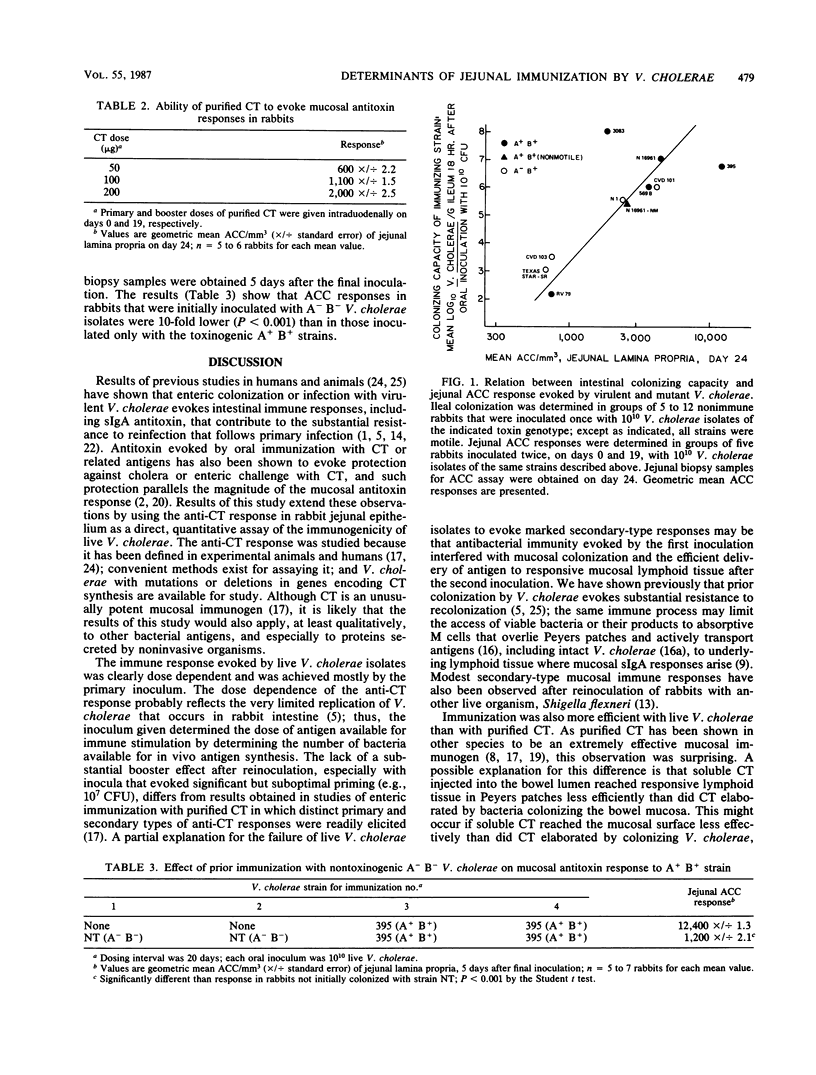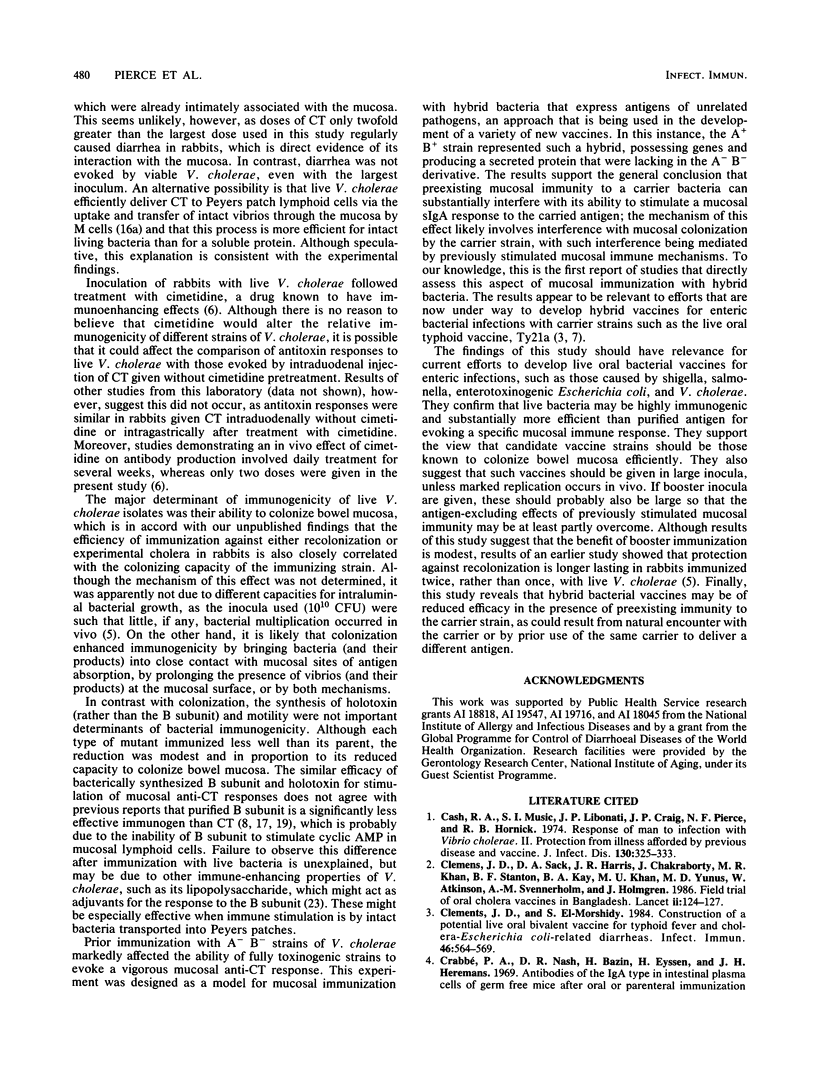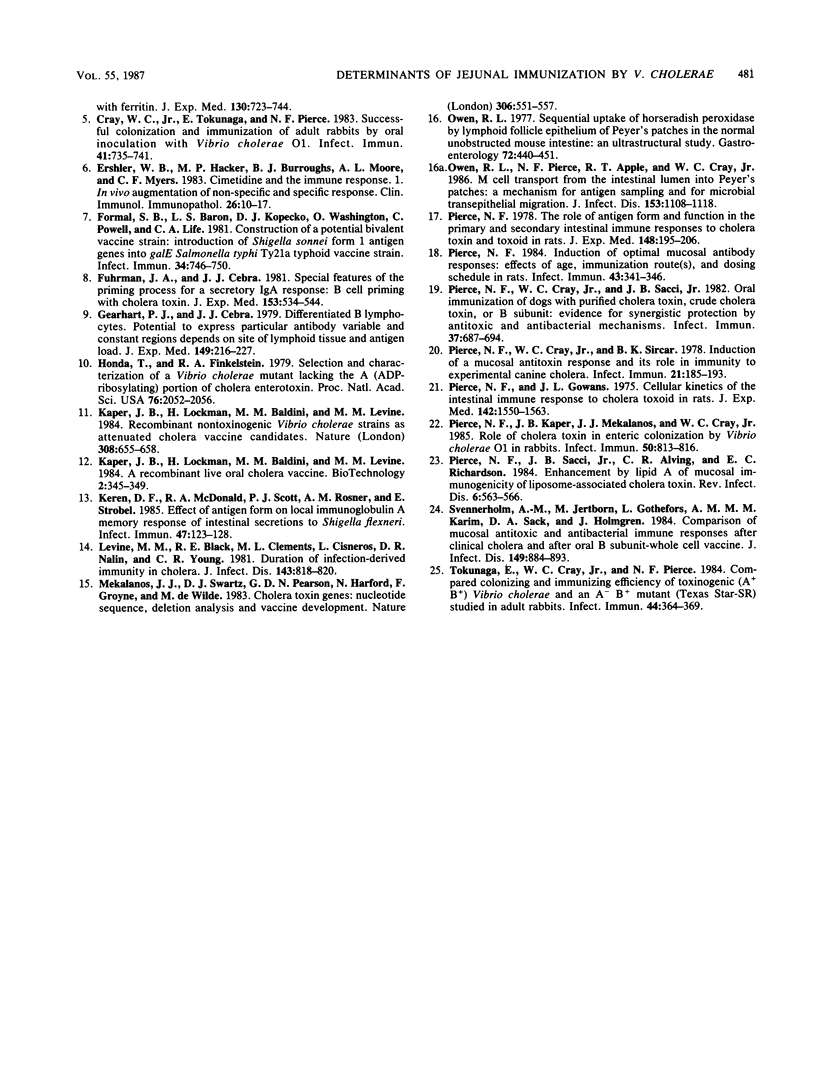Abstract
Determinants of the capacity of live Vibrio cholerae O1 isolates to evoke specific immune responses in intestinal mucosa were studied in rabbits, using mucosal immunoglobulin A (IgA) antitoxin as the measured immune response. Antitoxin responses were evoked mostly by the primary inoculation and were dose dependent; secondary-type responses were modest and occurred only when the booster inoculum was large, i.e., 10(10) CFU. The efficiency of mucosal immunization correlated closely with the mucosal colonizing capacity of the infecting strain and was otherwise independent of toxin genotype (A+ B+ or A- B+) or whether the strain was motile or nonmotile. Live bacteria evoked mucosal antitoxin more efficiently than did purified cholera toxin. Prior immunization with a nontoxinogenic (A- B-) V. cholera strain interfered significantly with the induction of mucosal antitoxin by subsequent immunization with its fully toxinogenic (A+ B+) parent. These results demonstrate the marked efficiency with which live V. cholerae stimulate a specific enteric mucosal secretory IgA response. They support the view that mucosal colonization aids efficient delivery of bacterial antigens to responsive subepithelial lymphoid tissue. This might occur by transfer of colonizing bacteria through M cells into Peyer patches or by efficient delivery of secreted toxin to M cells by mucosa-associated organisms. Preexisting antibacterial immunity interferes with colonization, which may prevent efficient antigenic stimulation and which may explain the relatively weak response to booster immunization. The same process may also limit the efficacy of hybrid enteric bacterial vaccines when there is preexisting mucosal immunity to the carrier organism due to either natural exposure or prior immunization with another vaccine that uses the same carrier.
Full text
PDF




Selected References
These references are in PubMed. This may not be the complete list of references from this article.
- Cash R. A., Music S. I., Libonati J. P., Craig J. P., Pierce N. F., Hornick R. B. Response of man to infection with Vibrio cholerae. II. Protection from illness afforded by previous disease and vaccine. J Infect Dis. 1974 Oct;130(4):325–333. doi: 10.1093/infdis/130.4.325. [DOI] [PubMed] [Google Scholar]
- Clemens J. D., Sack D. A., Harris J. R., Chakraborty J., Khan M. R., Stanton B. F., Kay B. A., Khan M. U., Yunus M., Atkinson W. Field trial of oral cholera vaccines in Bangladesh. Lancet. 1986 Jul 19;2(8499):124–127. doi: 10.1016/s0140-6736(86)91944-6. [DOI] [PubMed] [Google Scholar]
- Clements J. D., El-Morshidy S. Construction of a potential live oral bivalent vaccine for typhoid fever and cholera-Escherichia coli-related diarrheas. Infect Immun. 1984 Nov;46(2):564–569. doi: 10.1128/iai.46.2.564-569.1984. [DOI] [PMC free article] [PubMed] [Google Scholar]
- Crabbé P. A., Nash D. R., Bazin H., Eyssen D. V., Heremans J. F. Antibodies of the IgA type in intestinal plasma cells of germfree mice after oral or parenteral immunization with ferritin. J Exp Med. 1969 Oct 1;130(4):723–744. doi: 10.1084/jem.130.4.723. [DOI] [PMC free article] [PubMed] [Google Scholar]
- Cray W. C., Jr, Tokunaga E., Pierce N. F. Successful colonization and immunization of adult rabbits by oral inoculation with Vibrio cholerae O1. Infect Immun. 1983 Aug;41(2):735–741. doi: 10.1128/iai.41.2.735-741.1983. [DOI] [PMC free article] [PubMed] [Google Scholar]
- Ershler W. B., Hacker M. P., Burroughs B. J., Moore A. L., Myers C. F. Cimetidine and the immune response. I. In vivo augmentation of nonspecific and specific immune response. Clin Immunol Immunopathol. 1983 Jan;26(1):10–17. doi: 10.1016/0090-1229(83)90168-x. [DOI] [PubMed] [Google Scholar]
- Formal S. B., Baron L. S., Kopecko D. J., Washington O., Powell C., Life C. A. Construction of a potential bivalent vaccine strain: introduction of Shigella sonnei form I antigen genes into the galE Salmonella typhi Ty21a typhoid vaccine strain. Infect Immun. 1981 Dec;34(3):746–750. doi: 10.1128/iai.34.3.746-750.1981. [DOI] [PMC free article] [PubMed] [Google Scholar]
- Fuhrman J. A., Cebra J. J. Special features of the priming process for a secretory IgA response. B cell priming with cholera toxin. J Exp Med. 1981 Mar 1;153(3):534–544. doi: 10.1084/jem.153.3.534. [DOI] [PMC free article] [PubMed] [Google Scholar]
- Gearhart P. J., Cebra J. J. Differentiated B lymphocytes. Potential to express particular antibody variable and constant regions depends on site of lymphoid tissue and antigen load. J Exp Med. 1979 Jan 1;149(1):216–227. doi: 10.1084/jem.149.1.216. [DOI] [PMC free article] [PubMed] [Google Scholar]
- Honda T., Finkelstein R. A. Selection and characteristics of a Vibrio cholerae mutant lacking the A (ADP-ribosylating) portion of the cholera enterotoxin. Proc Natl Acad Sci U S A. 1979 Apr;76(4):2052–2056. doi: 10.1073/pnas.76.4.2052. [DOI] [PMC free article] [PubMed] [Google Scholar]
- Kaper J. B., Lockman H., Baldini M. M., Levine M. M. Recombinant nontoxinogenic Vibrio cholerae strains as attenuated cholera vaccine candidates. Nature. 1984 Apr 12;308(5960):655–658. doi: 10.1038/308655a0. [DOI] [PubMed] [Google Scholar]
- Keren D. F., McDonald R. A., Scott P. J., Rosner A. M., Strubel E. Effect of antigen form on local immunoglobulin A memory response of intestinal secretions to Shigella flexneri. Infect Immun. 1985 Jan;47(1):123–128. doi: 10.1128/iai.47.1.123-128.1985. [DOI] [PMC free article] [PubMed] [Google Scholar]
- Levine M. M., Black R. E., Clements M. L., Cisneros L., Nalin D. R., Young C. R. Duration of infection-derived immunity to cholera. J Infect Dis. 1981 Jun;143(6):818–820. doi: 10.1093/infdis/143.6.818. [DOI] [PubMed] [Google Scholar]
- Mekalanos J. J., Swartz D. J., Pearson G. D., Harford N., Groyne F., de Wilde M. Cholera toxin genes: nucleotide sequence, deletion analysis and vaccine development. Nature. 1983 Dec 8;306(5943):551–557. doi: 10.1038/306551a0. [DOI] [PubMed] [Google Scholar]
- Owen R. L., Pierce N. F., Apple R. T., Cray W. C., Jr M cell transport of Vibrio cholerae from the intestinal lumen into Peyer's patches: a mechanism for antigen sampling and for microbial transepithelial migration. J Infect Dis. 1986 Jun;153(6):1108–1118. doi: 10.1093/infdis/153.6.1108. [DOI] [PubMed] [Google Scholar]
- Owen R. L. Sequential uptake of horseradish peroxidase by lymphoid follicle epithelium of Peyer's patches in the normal unobstructed mouse intestine: an ultrastructural study. Gastroenterology. 1977 Mar;72(3):440–451. [PubMed] [Google Scholar]
- Pierce N. F., Cray W. C., Jr, Sacci J. B., Jr Oral immunization of dogs with purified cholera toxin, crude cholera toxin, or B subunit: evidence for synergistic protection by antitoxic and antibacterial mechanisms. Infect Immun. 1982 Aug;37(2):687–694. doi: 10.1128/iai.37.2.687-694.1982. [DOI] [PMC free article] [PubMed] [Google Scholar]
- Pierce N. F., Cray W. C., Jr, Sircar B. K. Induction of a mucosal antitoxin response and its role in immunity to experimental canine cholera. Infect Immun. 1978 Jul;21(1):185–193. doi: 10.1128/iai.21.1.185-193.1978. [DOI] [PMC free article] [PubMed] [Google Scholar]
- Pierce N. F., Gowans J. L. Cellular kinetics of the intestinal immune response to cholera toxoid in rats. J Exp Med. 1975 Dec 1;142(6):1550–1563. doi: 10.1084/jem.142.6.1550. [DOI] [PMC free article] [PubMed] [Google Scholar]
- Pierce N. F. Induction of optimal mucosal antibody responses: effects of age, immunization route(s), and dosing schedule in rats. Infect Immun. 1984 Jan;43(1):341–346. doi: 10.1128/iai.43.1.341-346.1984. [DOI] [PMC free article] [PubMed] [Google Scholar]
- Pierce N. F., Kaper J. B., Mekalanos J. J., Cray W. C., Jr Role of cholera toxin in enteric colonization by Vibrio cholerae O1 in rabbits. Infect Immun. 1985 Dec;50(3):813–816. doi: 10.1128/iai.50.3.813-816.1985. [DOI] [PMC free article] [PubMed] [Google Scholar]
- Pierce N. F., Sacci J. B., Jr, Alving C. R., Richardson E. C. Enhancement by lipid A of mucosal immunogenicity of liposome-associated cholera toxin. Rev Infect Dis. 1984 Jul-Aug;6(4):563–566. doi: 10.1093/clinids/6.4.563. [DOI] [PubMed] [Google Scholar]
- Pierce N. F. The role of antigen form and function in the primary and secondary intestinal immune responses to cholera toxin and toxoid in rats. J Exp Med. 1978 Jul 1;148(1):195–206. doi: 10.1084/jem.148.1.195. [DOI] [PMC free article] [PubMed] [Google Scholar]
- Svennerholm A. M., Jertborn M., Gothefors L., Karim A. M., Sack D. A., Holmgren J. Mucosal antitoxic and antibacterial immunity after cholera disease and after immunization with a combined B subunit-whole cell vaccine. J Infect Dis. 1984 Jun;149(6):884–893. doi: 10.1093/infdis/149.6.884. [DOI] [PubMed] [Google Scholar]
- Tokunaga E., Cray W. C., Jr, Pierce N. F. Compared colonizing and immunizing efficiency of toxinogenic (A+ B+) Vibrio cholerae and an A- B+ mutant (Texas Star-SR) studied in adult rabbits. Infect Immun. 1984 May;44(2):364–369. doi: 10.1128/iai.44.2.364-369.1984. [DOI] [PMC free article] [PubMed] [Google Scholar]


